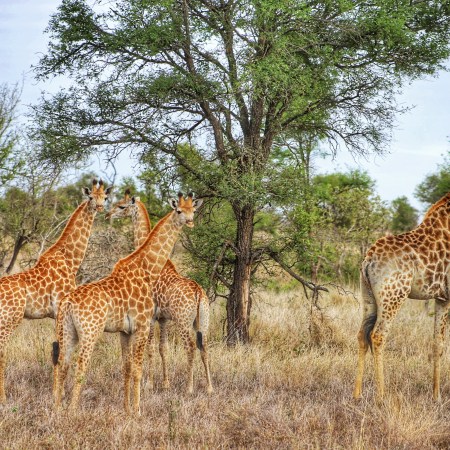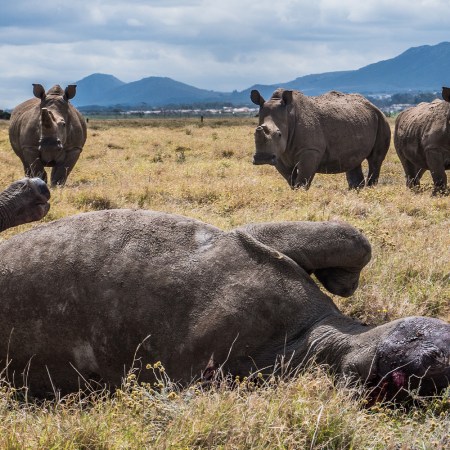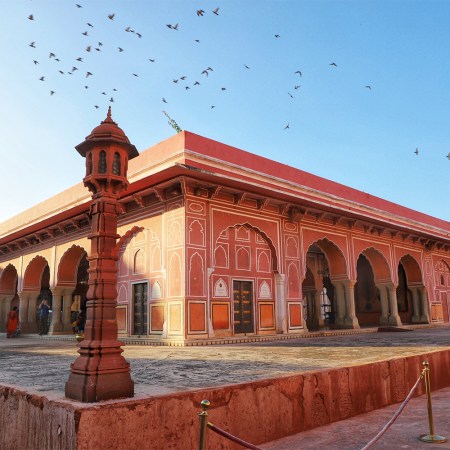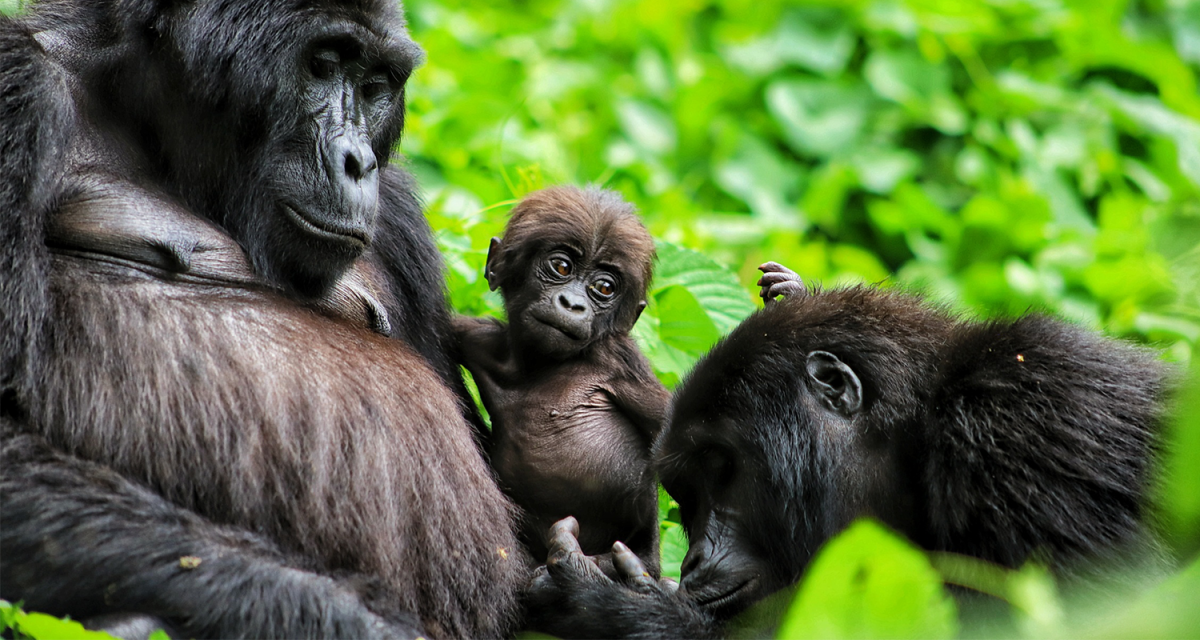
By Jake Emen
“Let’s go see our cousins.”
A guide who goes by the name Mister D. is leading myself and five other travelers to the Muhoza group of gorillas in Rwanda’s Volcanoes National Park. It’s first thing in the morning, and we’re embarking on a gorilla trek into the Virunga Mountains. Our goal is to find this family of 15 great apes headed by a silverback of the same name; “Muhoza” can be translated to “consolation,” as the imposing alpha had spent much of his adult life alone until asserting his dominance over this group and assuming status as kingpin, husband and father.
“He’s the boss,” says Mister D. “He’s handsome. He’s a big Buddha; very big and gentle.”
After walking for an hour, we leave an open pasture with towering volcanoes looming in the background and cross a threshold into dense jungle terrain, following Mister D. and his team as they machete open a path for us to wade through.
We know our contact with the gorillas will be imminent, but when they appear, it feels as if we’ve stumbled upon the family almost by surprise. They’re amid their morning “social hour,” a burst of activity fueled by fermented bamboo which has the gorillas feeling rambunctious, and, well, likely a bit buzzed.
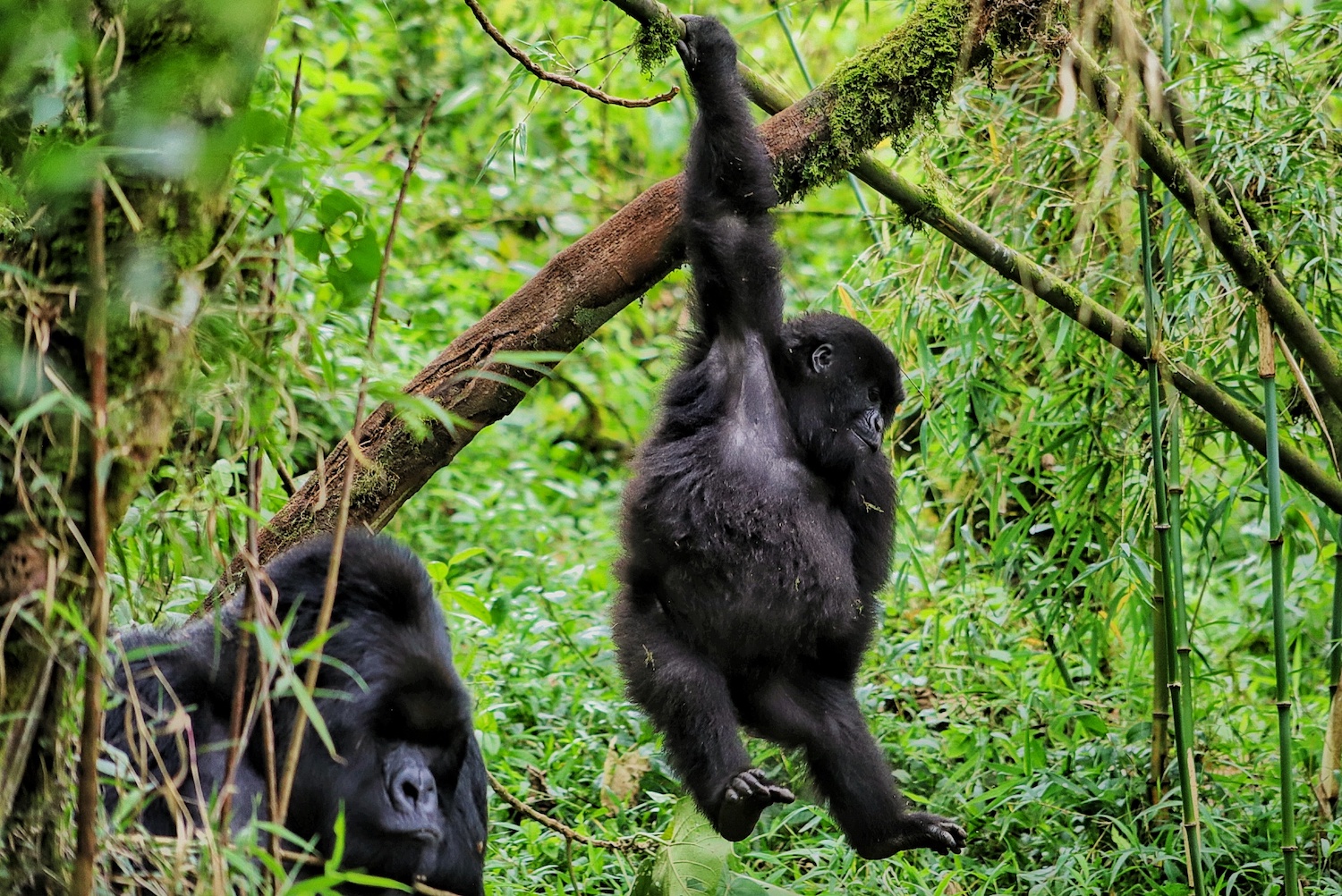
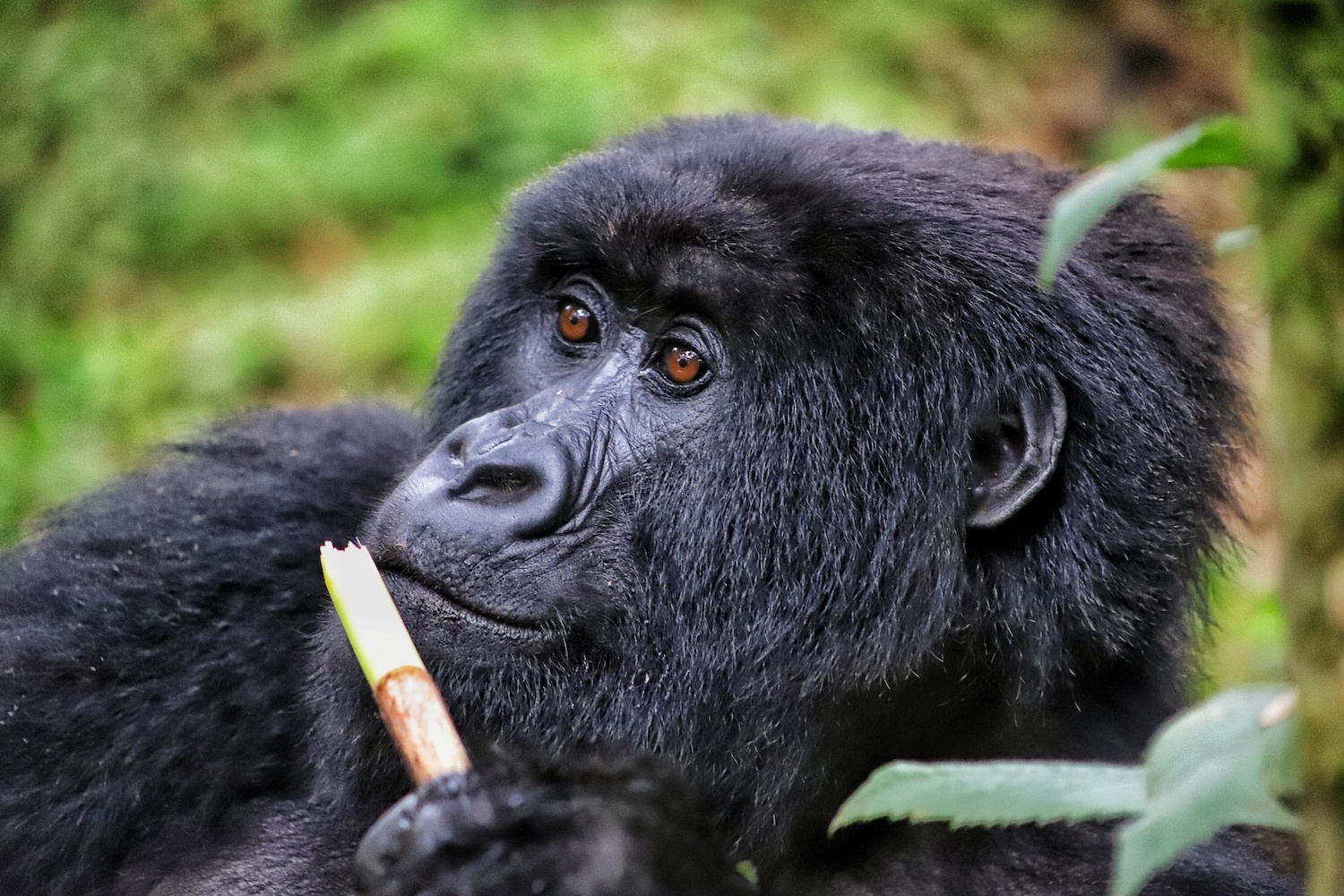
It’s our first expedition during a nine-night journey across Rwanda and Uganda with Volcanoes Safaris, stopping into each of its four lodges spread across the region. On the docket are two gorilla treks, along with tours to observe golden monkeys and chimpanzees, with additional time devoted to game drives, boat safaris and soaking up the area’s pristine surroundings, from mountain ranges to lush jungles and eventually down to the savanna. The operator is celebrating its 25th anniversary this year and launched a comprehensive 10-day itinerary to mark the occasion. Prices range from $11,865 to $16,270, including the cost of the necessary trekking permits, depending on the season, with the drier months of June to August and December to February being the most in demand.
In the jungle, we’re standing six feet away from a performance of gorilla theater unfolding before us in all directions. Adolescents are running back and forth, twirling around in circles and wrestling with one another, generally hell-bent on annoying the adults as much as possible with nonstop rumbling and tumbling throughout the group. Sound like any toddlers you know? Some are climbing branches and jumping back down, others are beating at the developing air sacks in their chests, while tiny babies are riding on the backs of mothers or aunts. Muhoza is sitting in the back and watching over the proceedings with stoic serenity, taking in the scene of his happy family and not bothered by a thing.
It’s not until the alpha gets up and starts walking around that you realize how enormous and powerful he is, more than 400 pounds of rippling muscle with a bulging barrel chest and chiseled arms, the trademark silver and white fur covering an imposing back that would make The Rock envious. He’s calm, but his presence emanates a clear message: “Do not fuck with me.”
Our group does our best to do just that, keeping our mandated distance from the apes while playing the role of observers rather than participants in the action. When a gorilla comes too close in our direction, a guide is quick to grab us and move us away, while offering a guttural imitation groan.
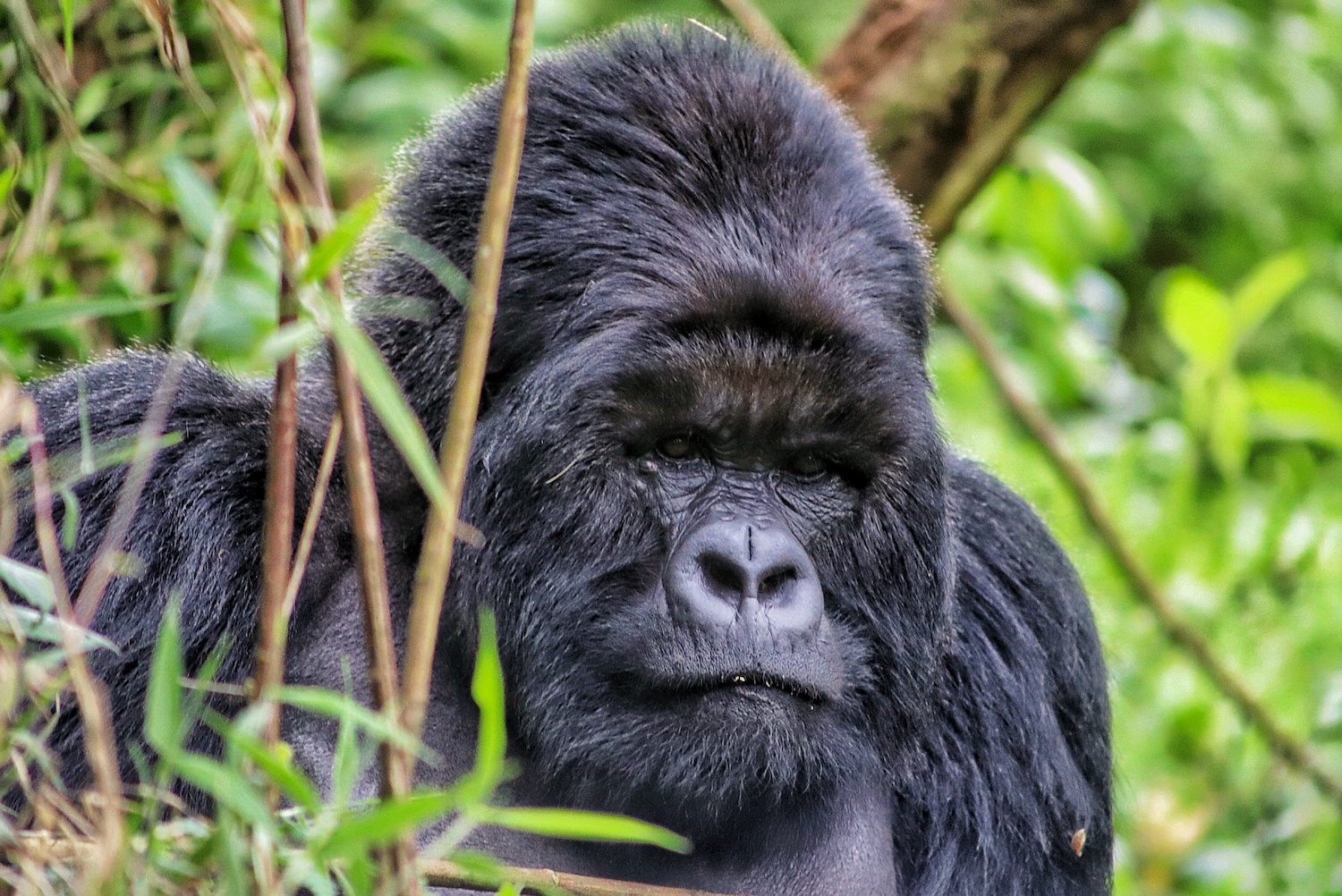
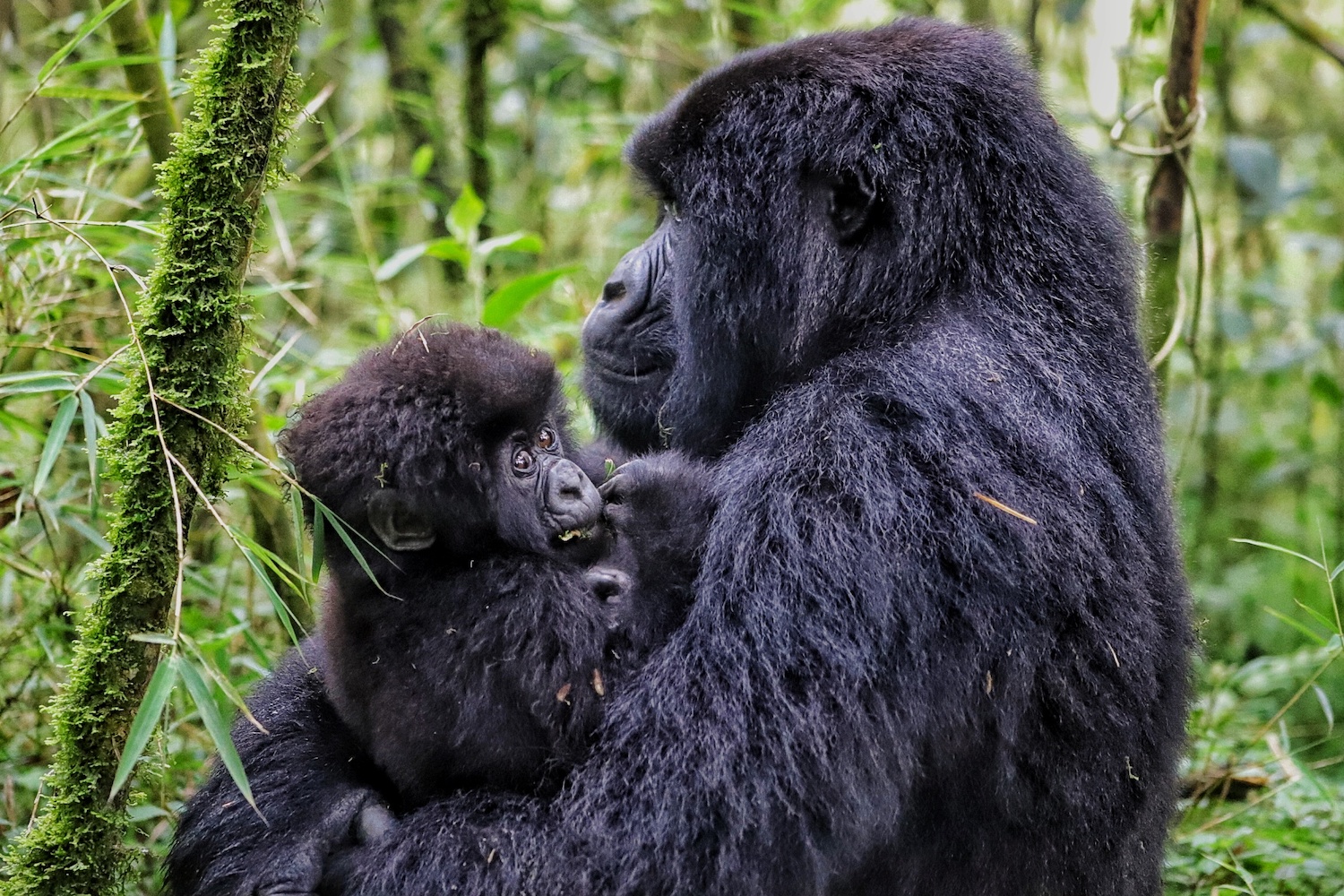
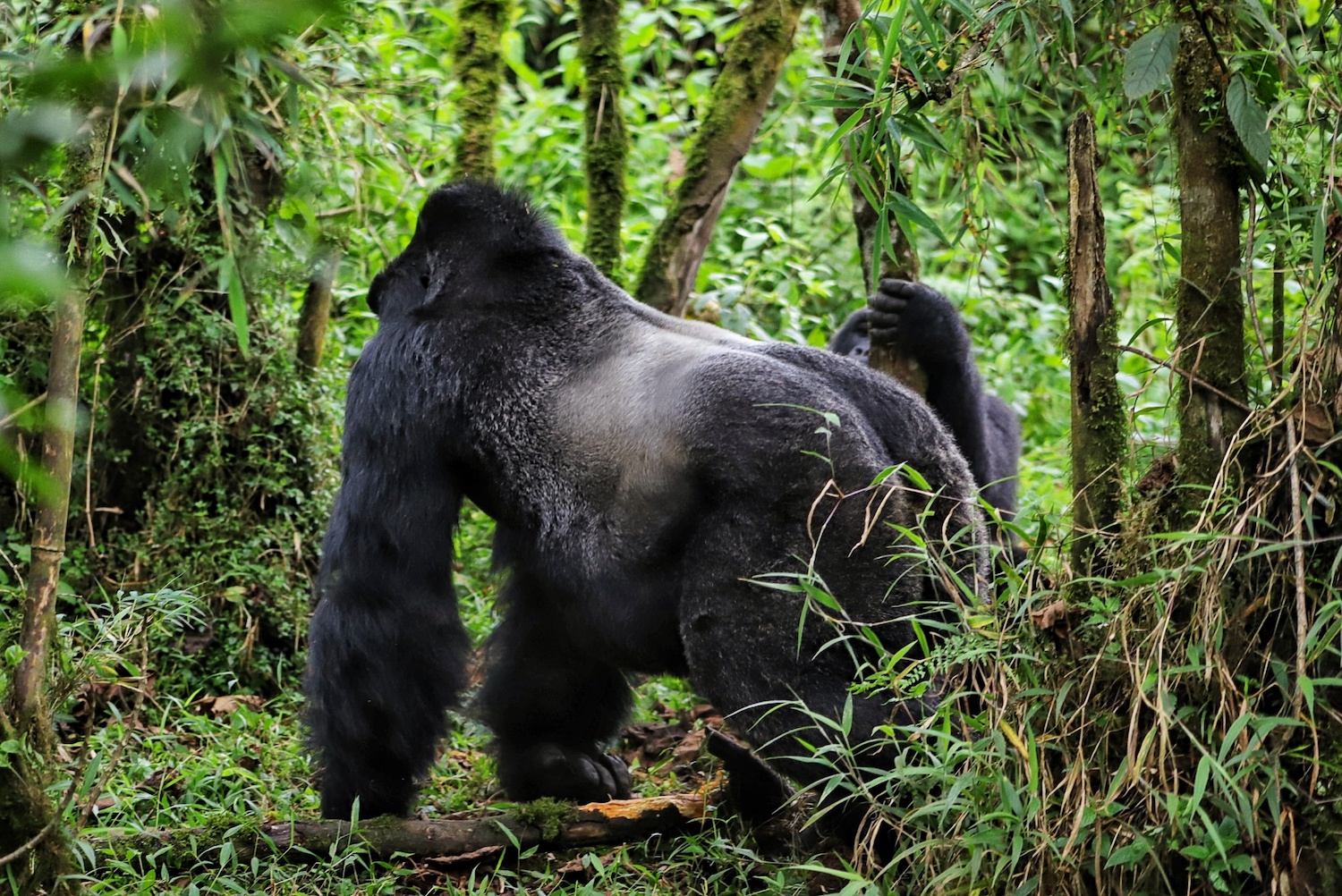
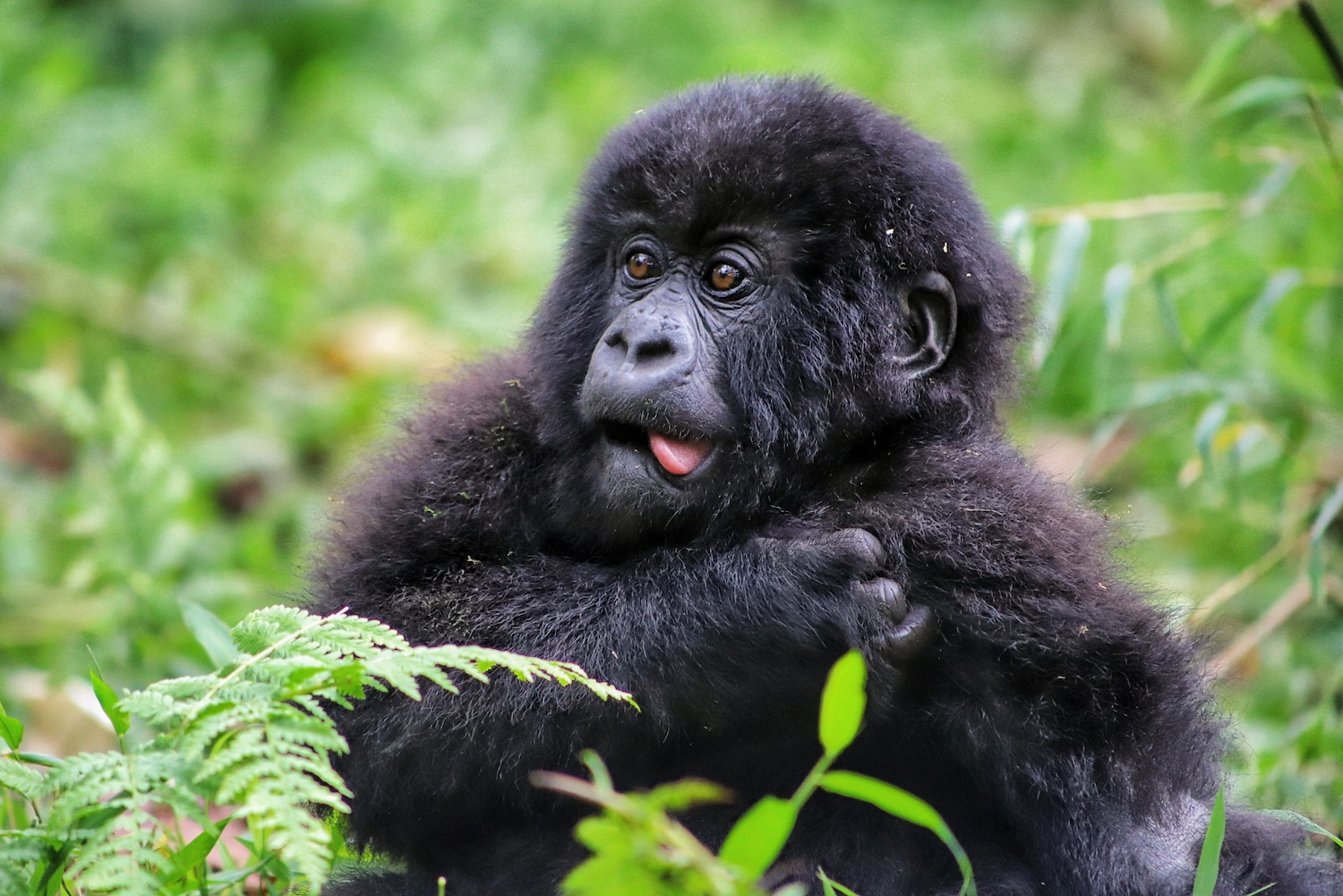
At this distance, mere feet away from the gorillas, we’re able to witness the caring relationships between the animals. A mother holds her infant to her chest and smiles into the distance as the curious baby peers up, a moment of incredible tenderness. How sweet and gentle and nurturing they are, how caring; as long as you don’t spur Muhoza into action, of course, who’s currently busying himself with taking on a tag-team assortment of youth who’ve decided to jump atop and attempt to subdue him. Time for a bit of instruction on what it means to be an alpha male. And on that note, one of the females approaches Muhoza and tries sidling up to the big fella. “Look, she wants jiggy jiggy,” Mister D. says. But he’s either tired out from playing with the kids or otherwise uninterested, and passes on the opening.
As the gorillas move about, we shadow them around the trees, maximizing our allotted one hour of time with the gentle beasts, our evolutionary cousins. “When you see these animals who share more than 98% of your DNA, you can interpret their emotions and behaviors and strategies,” says Yassin Maridadi, one of our guides with Volcanoes Safaris.
It’s easy to see the intellect and emotion behind their bright amber-mahogany eyes, and recognize a bit of yourself in there, too. How anyone can see that for themselves and still want to poach or hunt them is a riddle I have yet to solve. It’s an awe-inspiring privilege to get this close to these endangered animals who have such an obvious, striking similarity to ourselves, and to whom we have done so much harm.
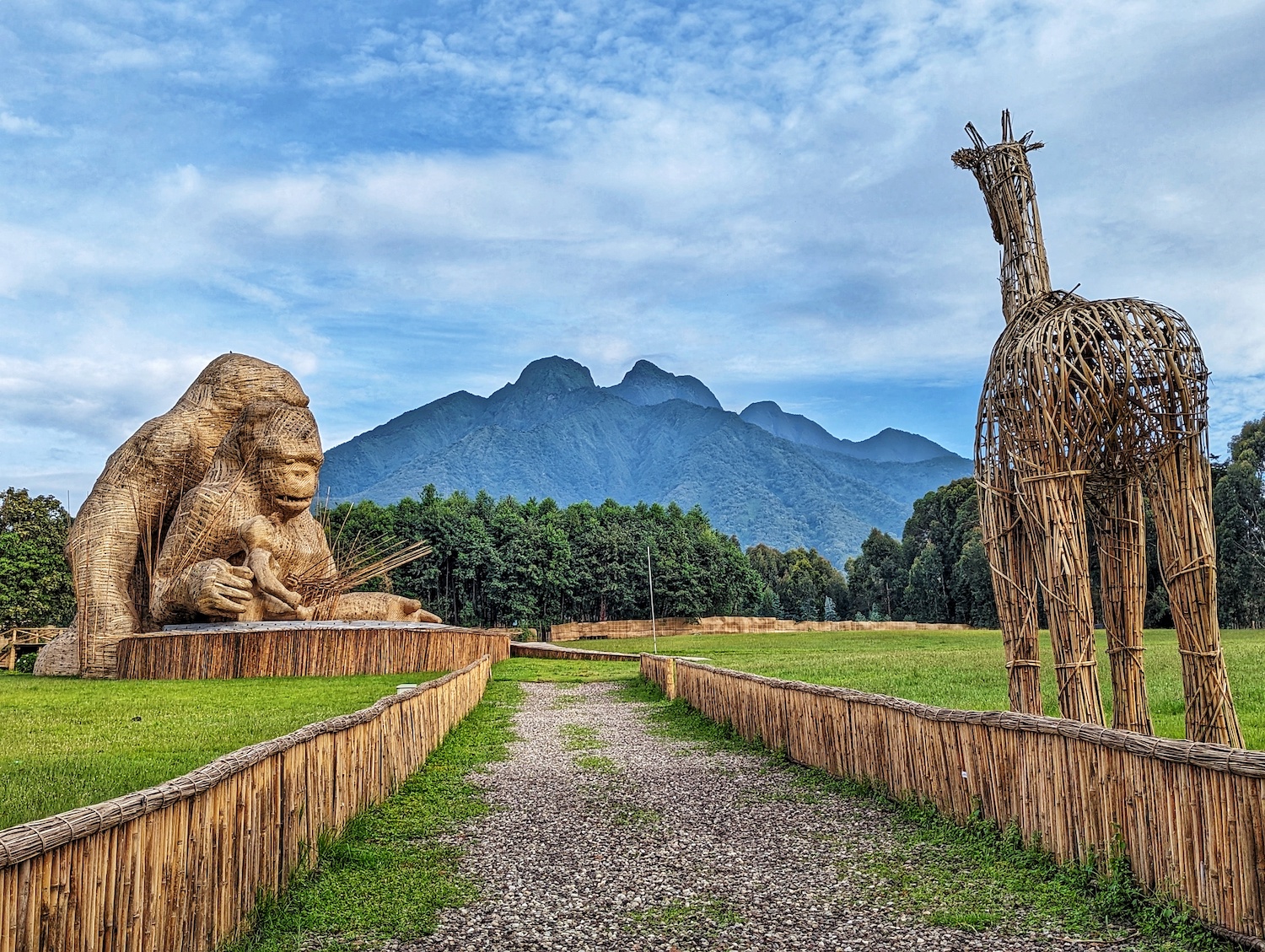
Gorilla Trekking in Rwanda and Uganda
Gorilla trekking is available across the Albertine Rift, which flows across national parks watched over by Rwanda, Uganda and the Democratic Republic of the Congo. It doesn’t come cheap, though. In Rwanda, for instance, a permit costs $1,500 per person per trek; in Uganda, the price is $750. These funds provide the means to protect the animals, and mountain gorillas have been one of the world’s most successful conservation stories in recent decades. Their numbers have increased to more than 1,000 after bottoming out at around 300, and while such gains may be tenuous and the species is still endangered — threatened by humans and our diseases, along with habitat loss and degradation — they nonetheless have been enjoying an odds-defying upward trajectory.
Tourism dollars are a big part of that picture, along with the work from dedicated organizations such as the Dian Fossey Gorilla Fund, the Jane Goodall Institute, Gorilla Doctors and Conservation Through Public Health. The Fossey Fund just opened its Ellen DeGeneres Campus — half of the $15 million budget was funded by DeGeneres and wife Portia de Rossi — which serves not only as an active research site filled with laboratories, but also as an educational center and attraction. Free to the public, the campus has attracted tens of thousands of visitors in its first year. That includes a larger share of locals than tourists, a crucial bit of education and outreach for a populace which does not have the means of taking the gorilla treks wealthy foreign visitors do, and otherwise lack a firsthand chance to be wowed by the majestic animals.
Gorilla tourism is strictly limited and monitored. The treks allow for up to one hour of direct observation time with a particular gorilla group per day, with a maximum of eight tourists per group. These days, protocols also include taking a PCR test prior to embarking, and wearing a mask while in close proximity with the great apes. Gorilla groups need to be habituated before coming into contact with tourists — there are several dozen habituated groups across the region — a process which could take between five and seven years, and results in their acceptance of the slow, awkward, noisy and hairless relations who come to gawk at them. Different families have different territories, and treks are roughly divided into easy, moderate and hard groups, based upon how lengthy and arduous the hike is to meet them.
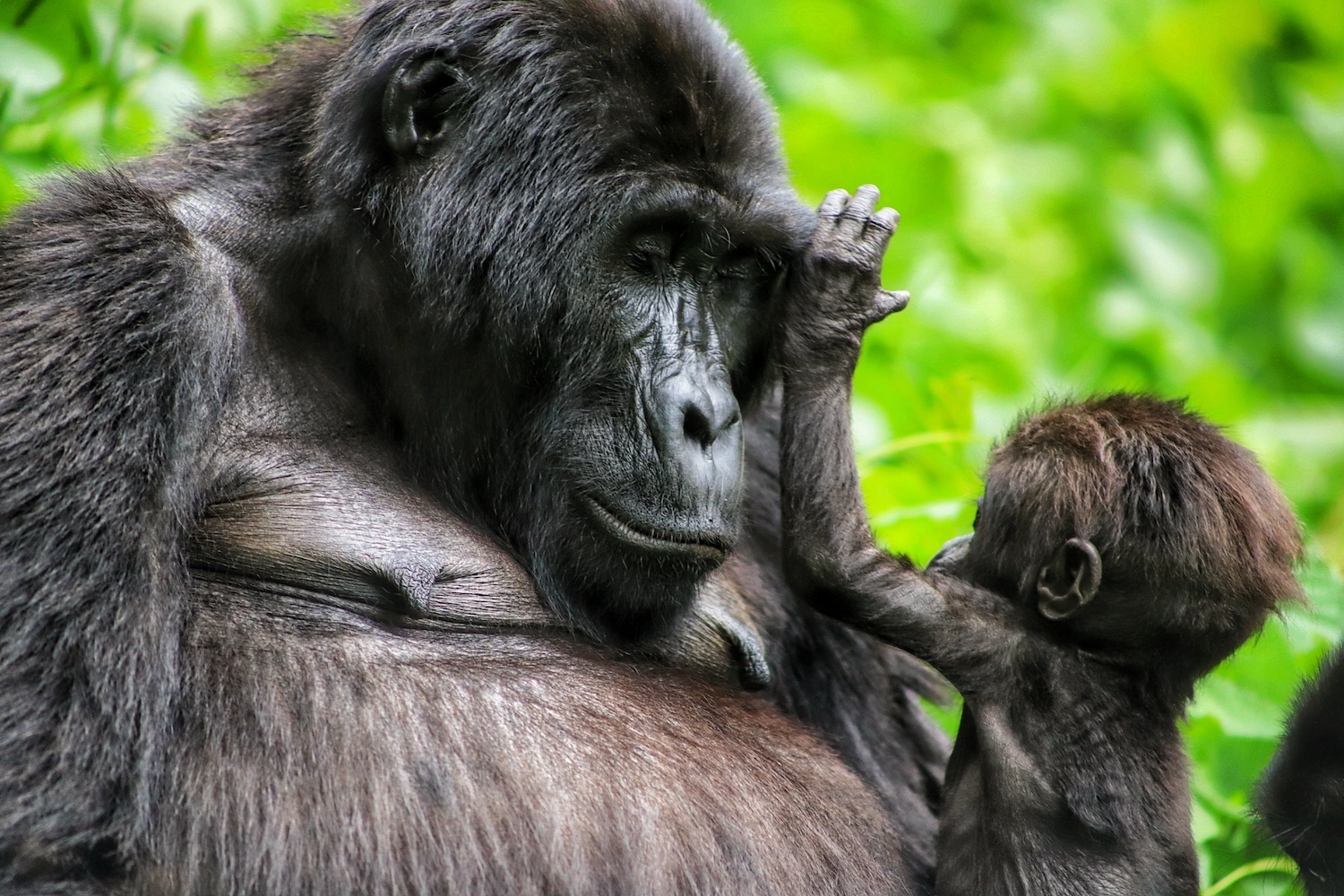
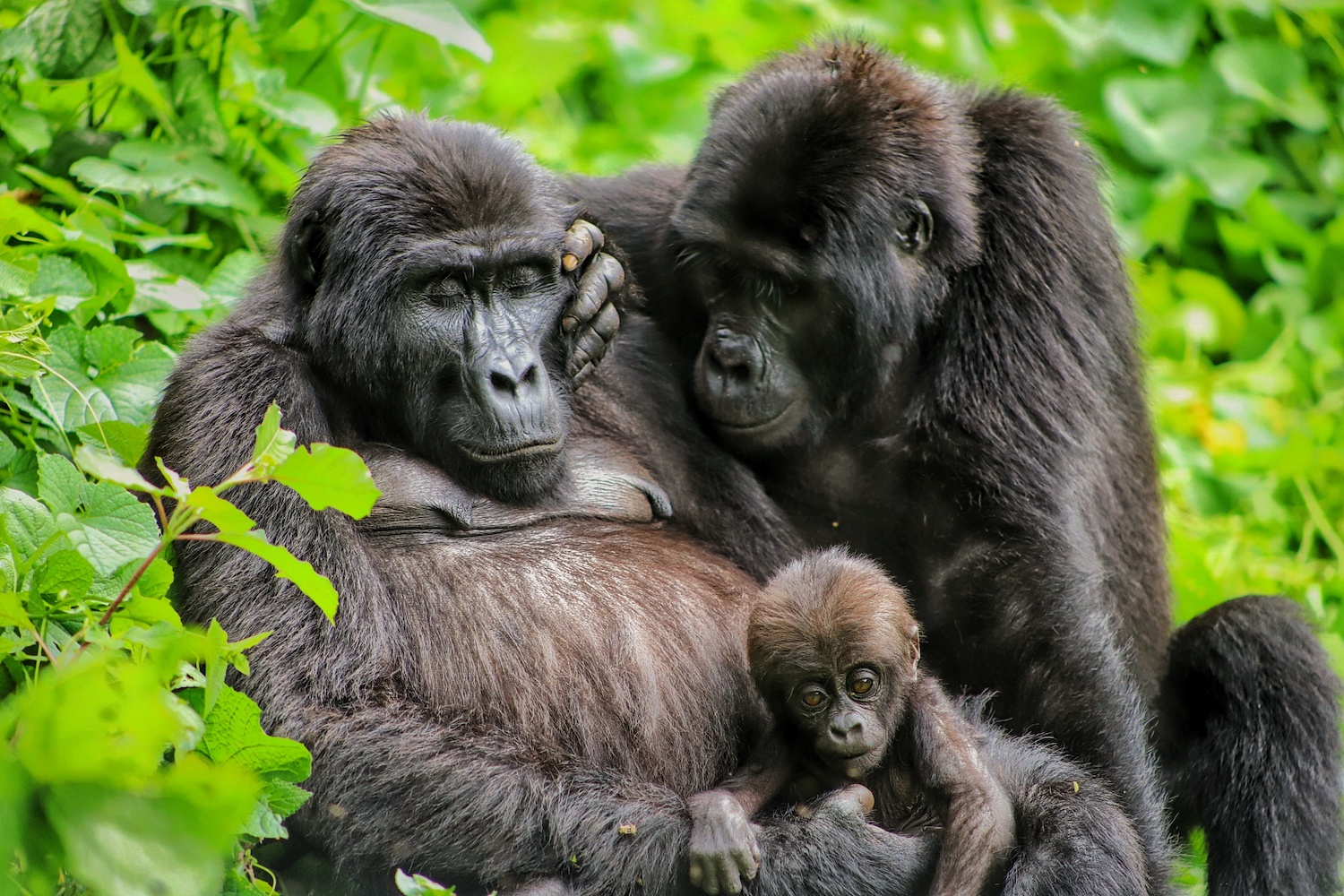
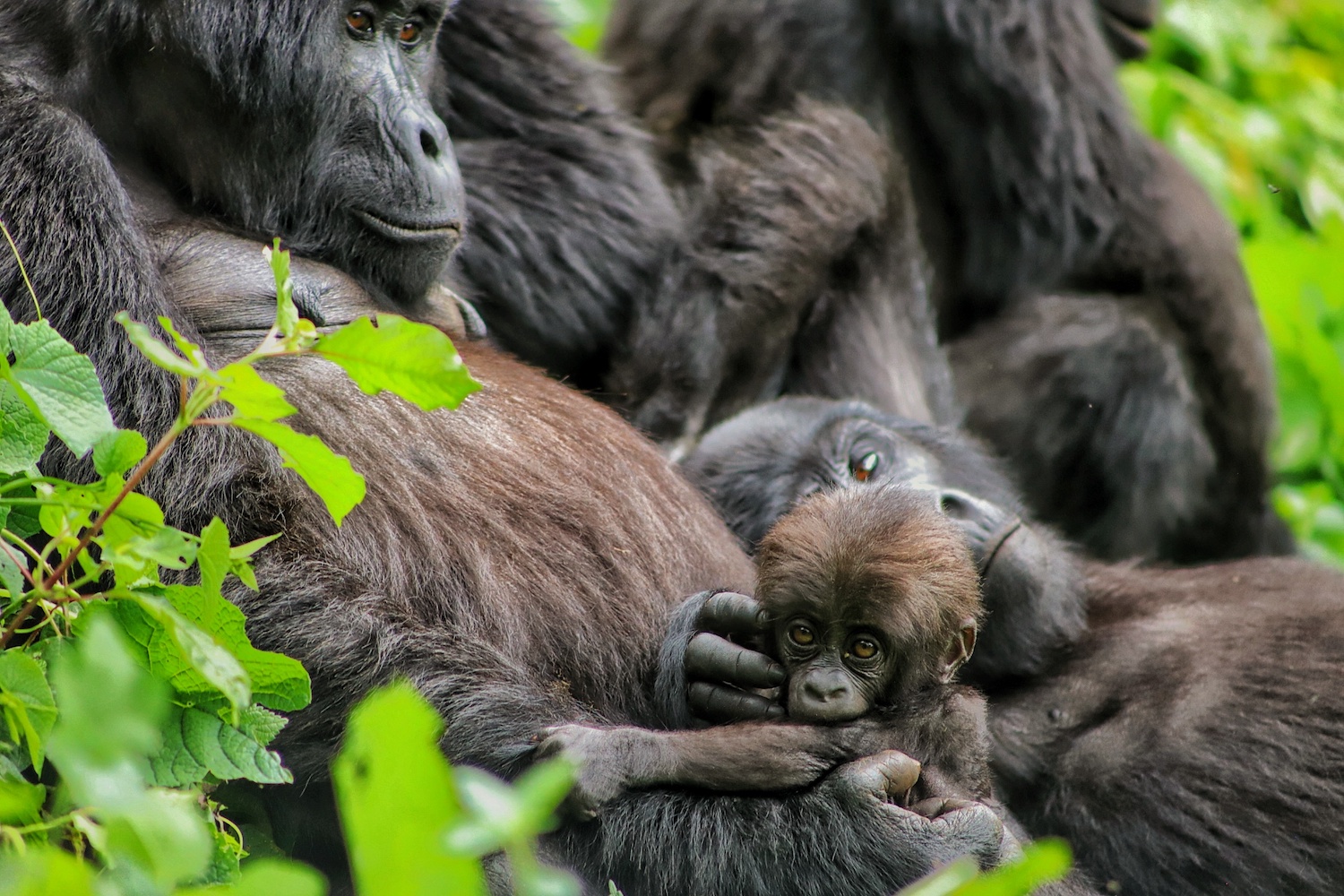
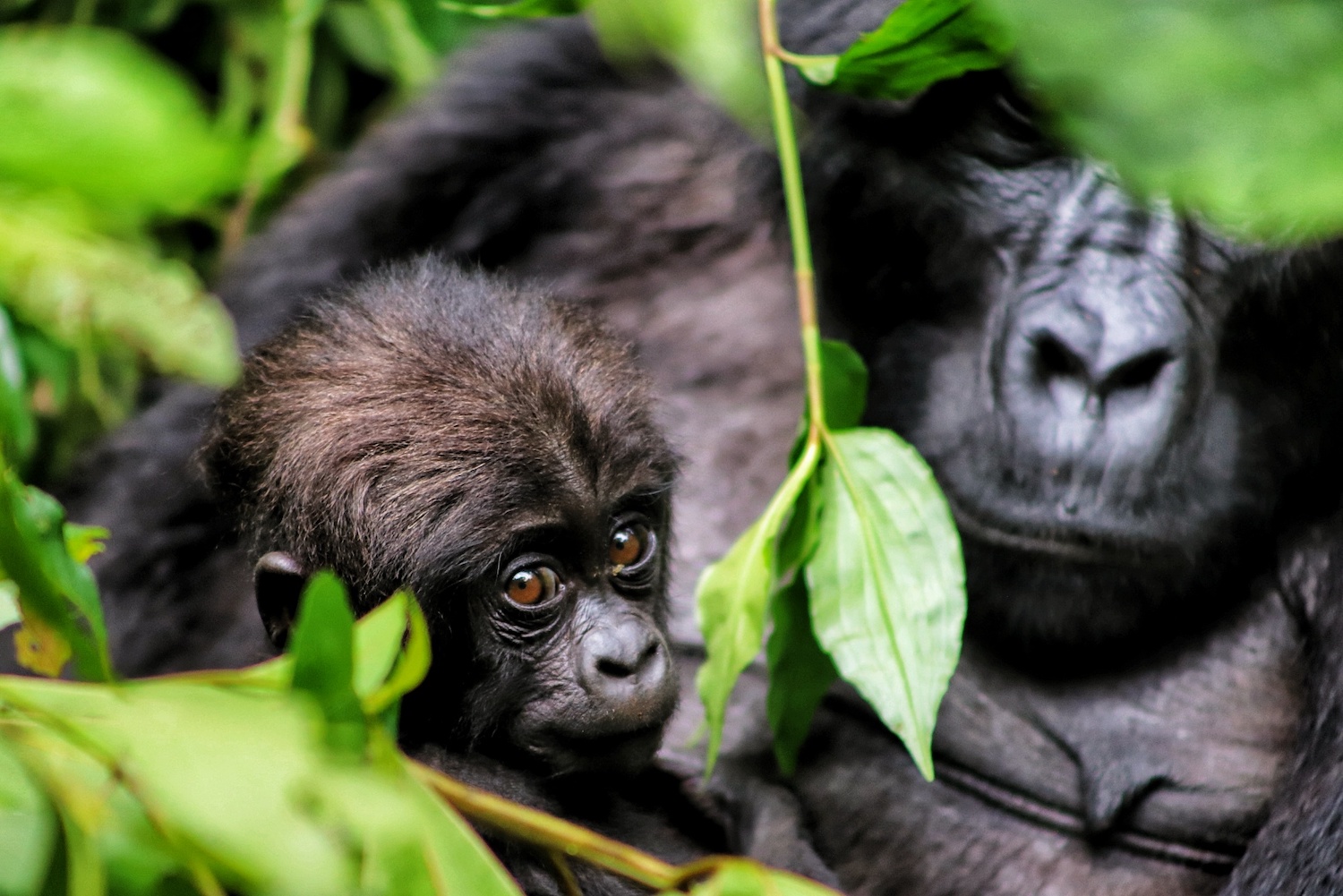
Before and after such jaunts, you’ll be posting up at your lodge, and Volcanoes Safaris has four spread across the ecosystem, including the Virunga Lodge in Rwanda where we began our journey and met Muhoza, as well as the Mount Gahinga, Bwindi and Kyambura Gorge lodges in Uganda. The home bases share much in the way of sensibilities and setup, while differing in terms of their environs and their resulting look and feel.
Rooms at each are standalone bungalows, or bandas, featuring amenities such as canopy beds, fireplaces, sitting nooks, and generally ample hot water and wifi. They’ll be your home away from home as you come to appreciate the inimitable rhythms of safari life: early morning wakeup calls followed by a dose of thrilling adrenaline and almost overwhelming emotion courtesy of the great apes, with multi-course meals and nightly sundowner cocktails spaced between afternoon excursions and leisure time.
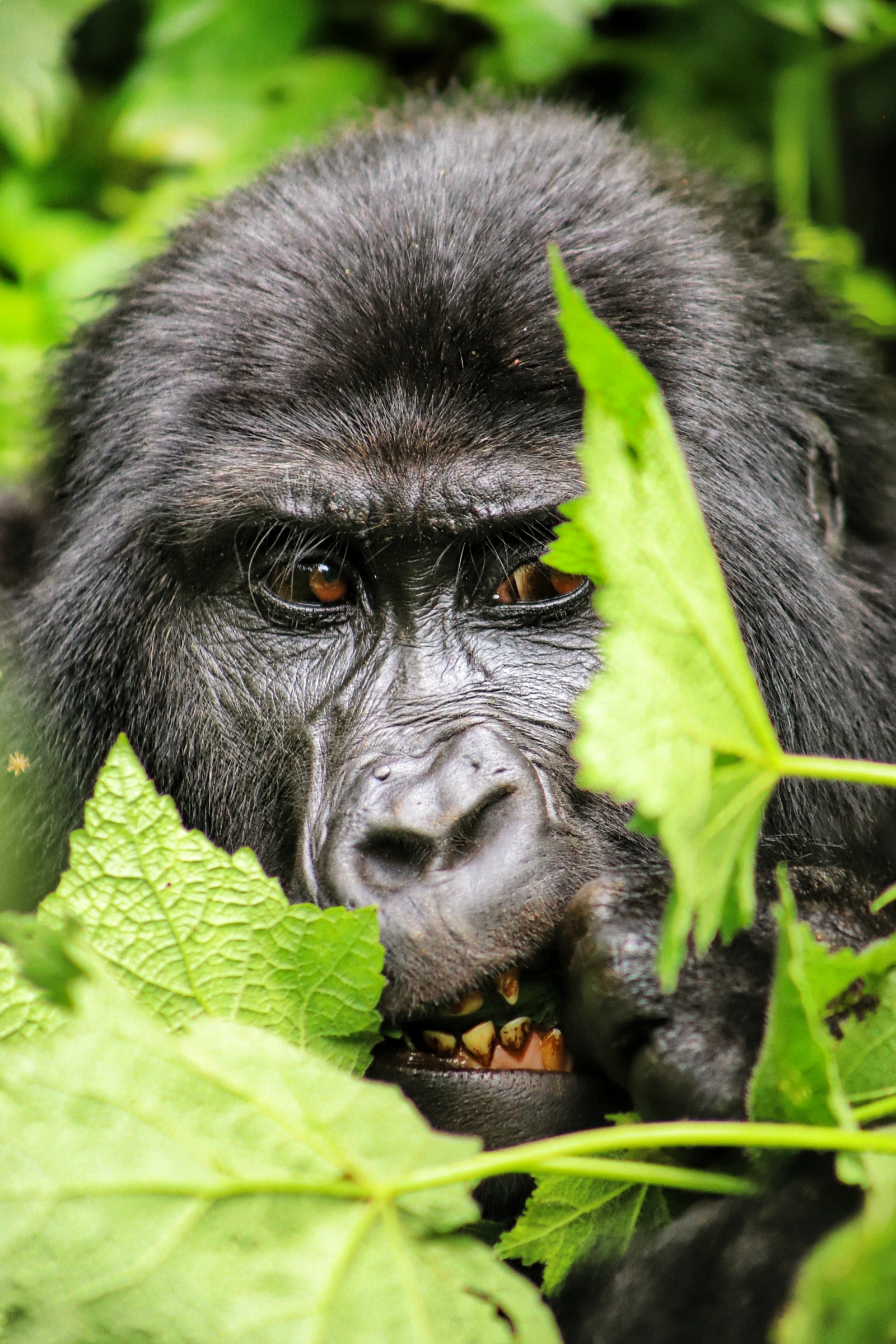
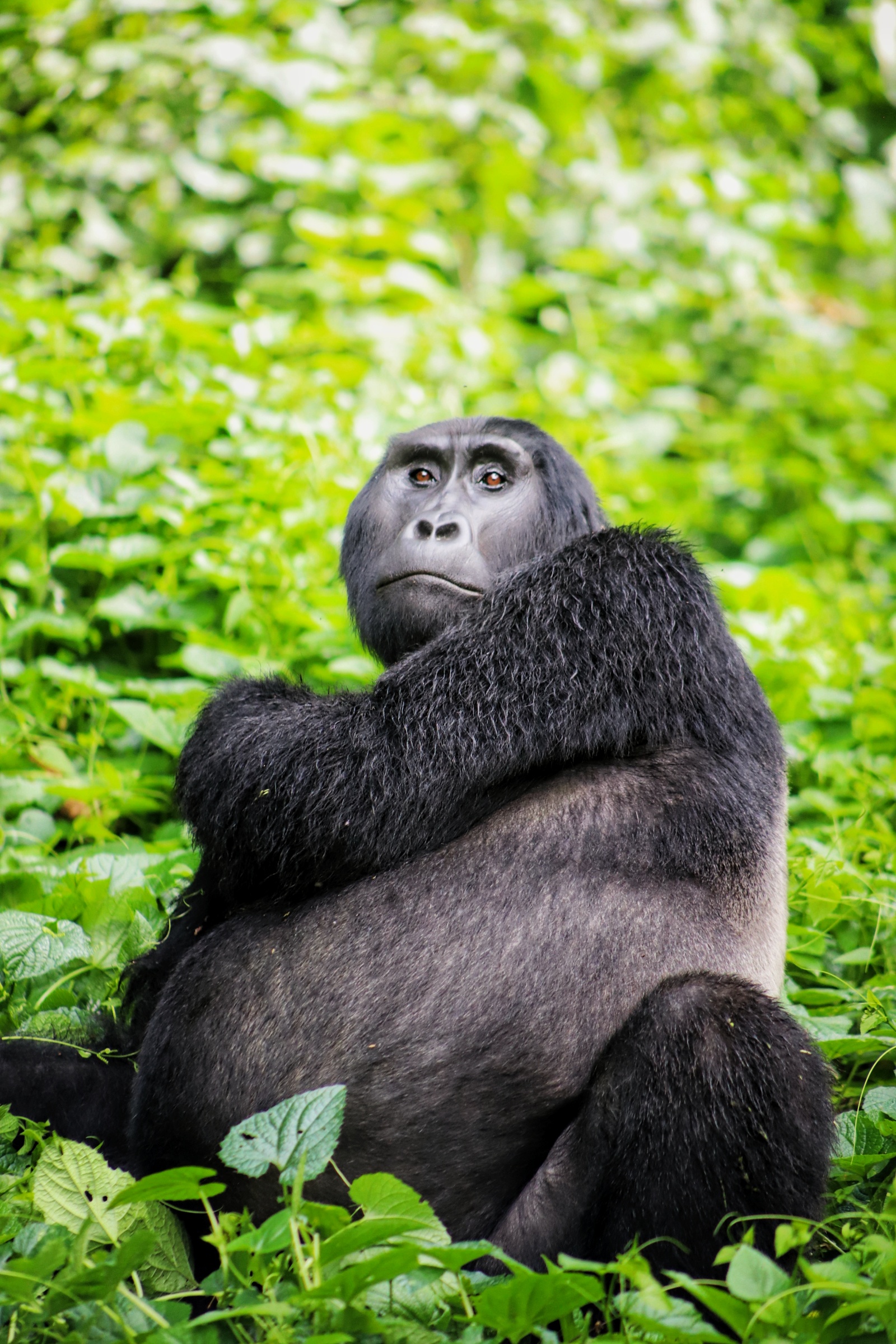
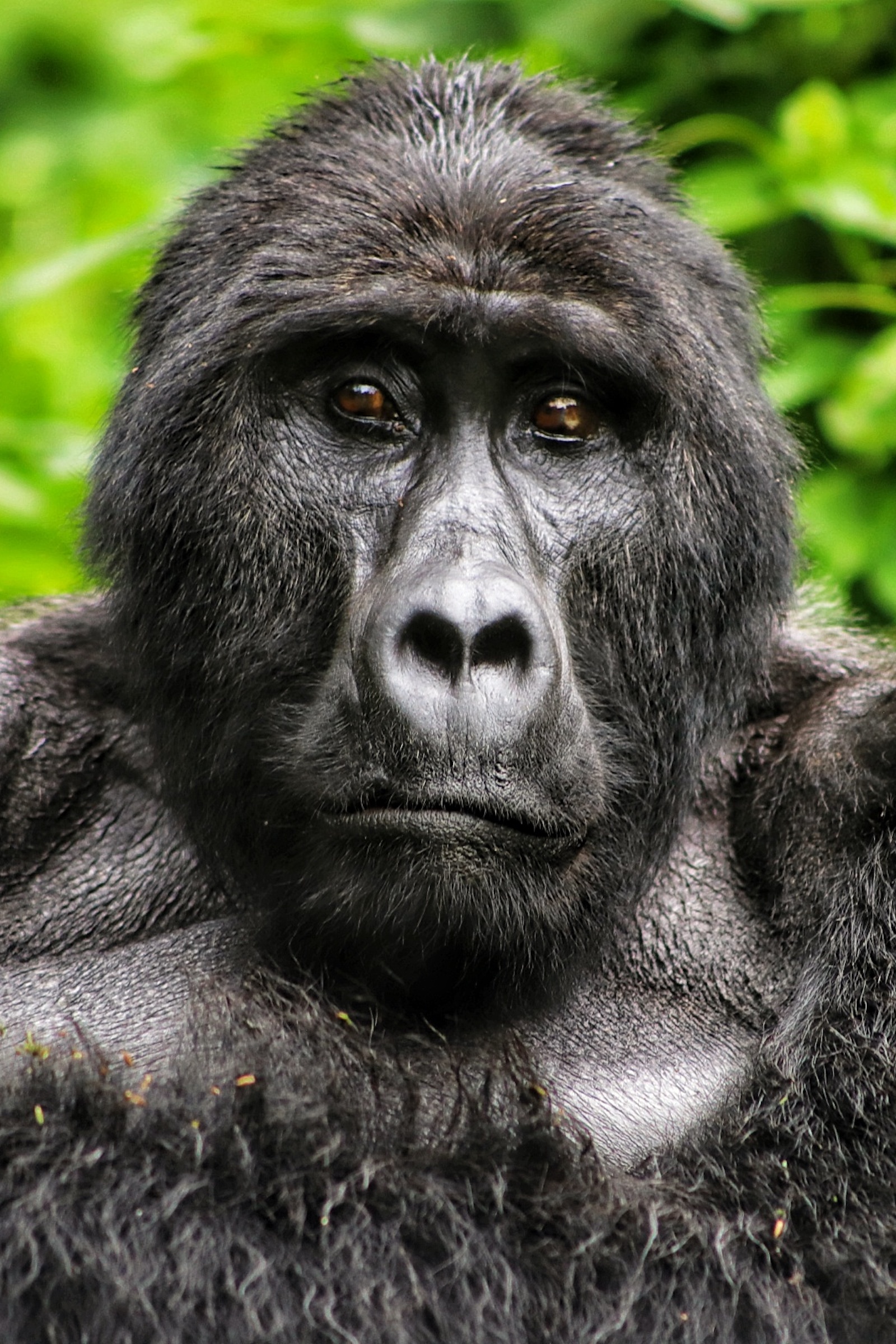
Our second gorilla excursion offered an entirely different viewing experience than the first. Gone was the frenetic energy of twirling and wrestling seen on display during Muhoza’s social hour, replaced with a quiet session of relaxation and cuddling observed in the Habinyanja group in Uganda’s Bwindi Impenetrable Forest National Park. This band of 13 had two silverbacks among them, including the namesake alpha, along with a tiny baby born in April of this year, only seven months old and no bigger than a human infant during our visit. The family kept busy hugging and loving and nitpicking and cleaning, occasionally noshing on bamboo and then dozing into food comas.
While based at the Mount Gahinga Lodge, we also ventured into Mgahinga Gorilla National Park for golden monkey trekking, with the park sporting the tagline “Where gold meets silver” due to the presence of both endangered species. Reaching these particular primates requires an intensive, six-hour round-trip hike into the high-elevation virgin bamboo forest the animals call home, though they’re more than worth the exertion.
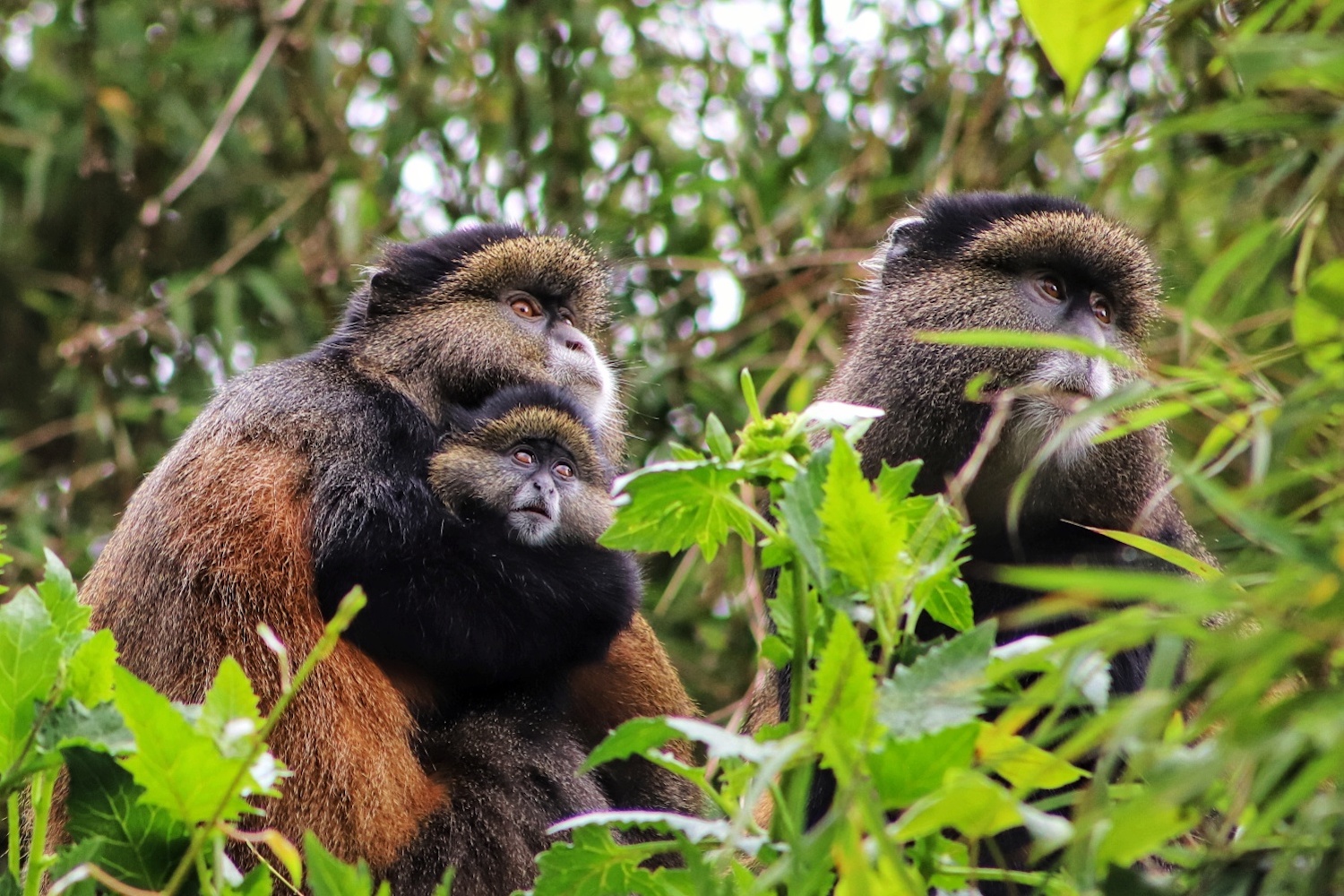
Golden monkeys are only found in the Virunga Mountains, with current estimates of the species putting the population at around several thousand individuals. One group in Mgahinga, with about 30 members, is habituated and available for trekking excursions, during which you’ll observe the monkeys climbing to the top of towering bamboo shoots and nimbly jumping between them, as little ones, still more tail than body, follow closely behind their elders and do their best to keep up.
While golden monkeys are so named because of the striking paintbrush streak of gold down their backs, be forewarned that the name is said to be apt for another reason as well, as they’re known to enjoy giving visitors golden showers. Choose your steps wisely, then, should these monkeys be overhead.
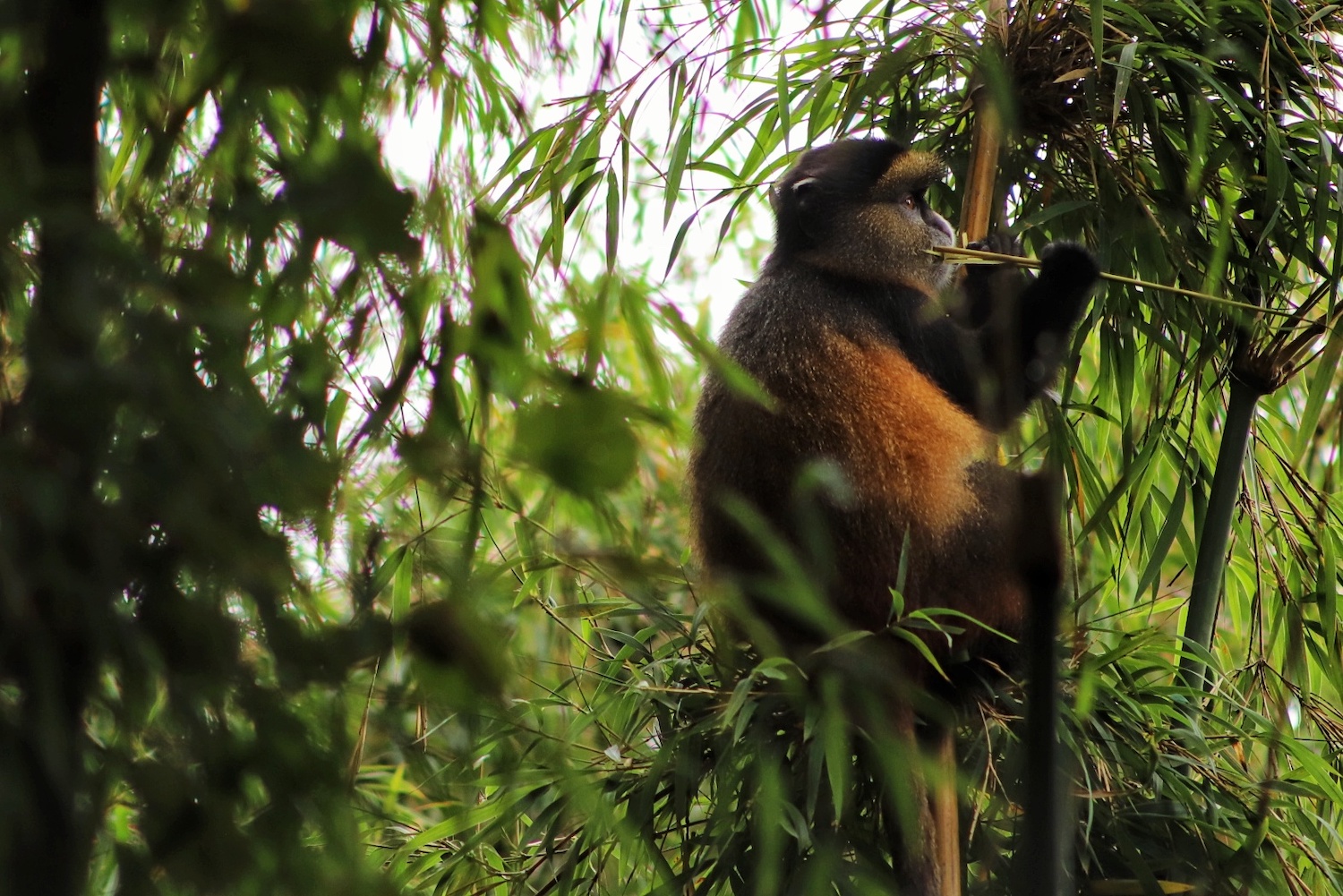
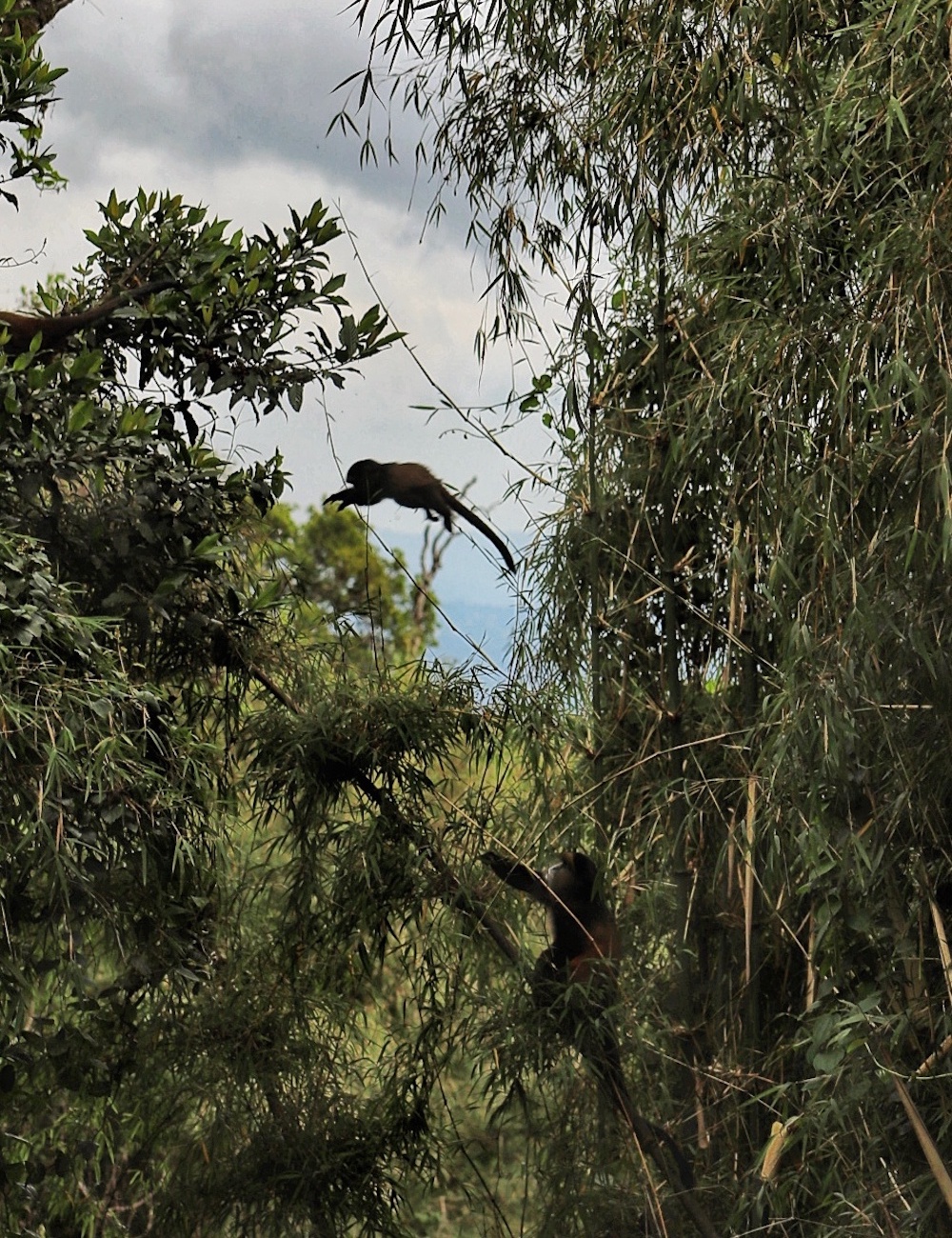
Adventures (and Misadventures) Abound
Our final excursion was a trek down into the Kyambura Gorge with the goal of visiting its famed lost chimpanzees.
About a quarter century ago, a group of chimps got stranded in the gorge, a 100-meter-deep, 10-kilometer-long ravine. It’s a wild topographical feature that appears as if a rift has opened in the earth’s crust that would take you straight down into a mythological underworld below. Without being able to intermingle with other groups, the lost chimps have seen their population dwindle as a result, though observers rejoiced when a new female managed to find her way to them several years ago, providing much needed genetic diversity and breeding capability.
While optimism has returned in regards to the fate of the lost chimps, our trek proved to be ill-fated from the start. Driving towards the gorge, our two vehicles pulled in behind a Land Cruiser stuck in the mud. Its driver had abandoned the beached vehicle in the middle of the road, blocking our path.
It was the only viable route into the park, and therefore the only way to the chimps; there wasn’t a choice in the matter but to take action. Our guides Sam Tanganika and Petrus Kiweewa were unable to move the vehicle on their own, so several of us passengers jumped out of our rides to lend a helping hand. Unstoppable force meets immovable object time, ladies and gentlemen. After walking mere paces from the vehicle, our feet sinking deep into the slop as we went, our guides opted instead to go barefoot as the thick mud was employing its super-strength suction. It was clear why the 4×4 got stuck.
We laid rocks and branches down under the vehicle’s tires for traction, and heaved and hoed for the better part of an hour, moving the SUV inch by inch, if at all. After calling in more support, and contorting ourselves to fully horizontal positions in strain, we were able to rock the vehicle back and forth just enough to finally, finally get it moving.
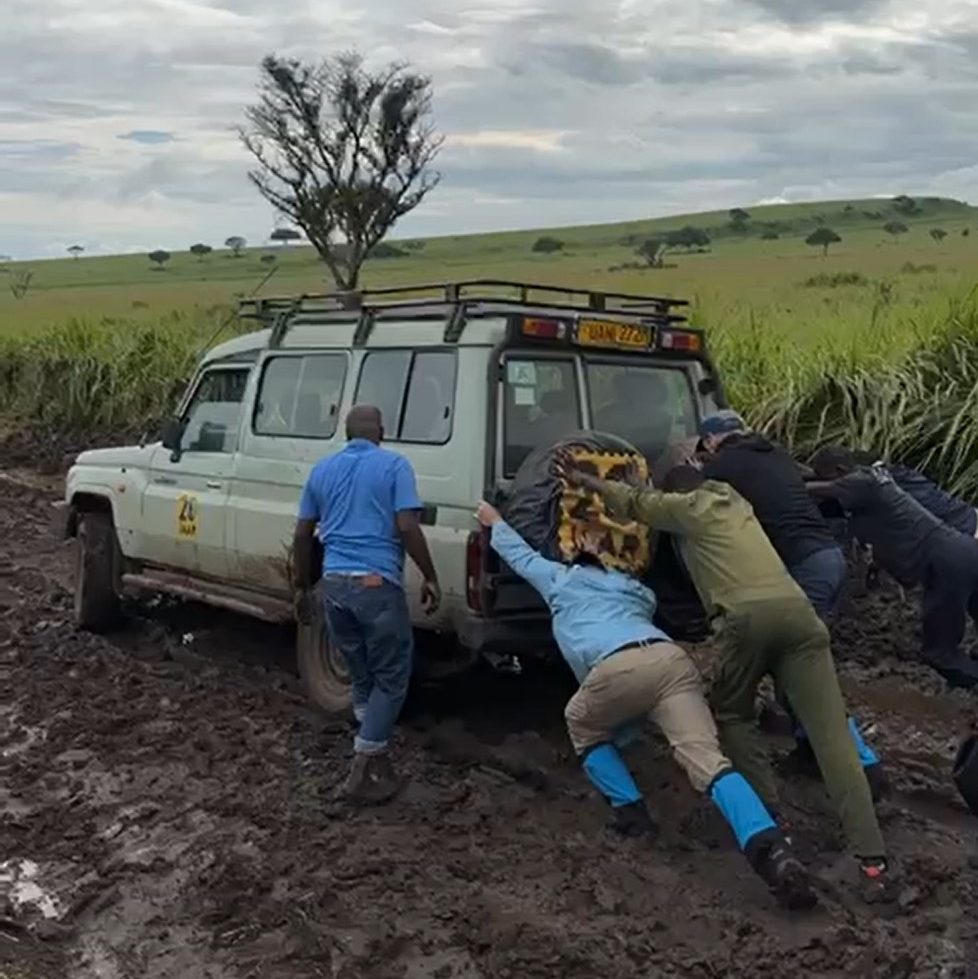
The effort and delay was more than worthwhile knowing that the payoff would be a chance to view the chimpanzees — and after that effort, there was no way we’d be stopped now. Except it turned out that the unseasonable rains, which had so severely muddied the roads, had also flooded the gorge’s river. The rising waters proved to be another barrier not only in our paths, but in that of the chimps, who chose to stick to the trees in a dryer locale. We ventured into the soggy habitat nonetheless, patiently following the trackers who attempted, in vain, to spot the apes for us. We could have waded through waist-high, hippo-infested waters in a puncher’s chance, last-ditch attempt to find them, but sometimes discretion is the better part of valor when you’re risking a close encounter with the massive four-legged tanks regarded as the most dangerous and deadly animals in Africa.
The payoff, then, was never paid. But after a memorable morning we took a boat ride through the Kazinga Channel between Lake Edward and Lake George, and were treated to a sensational menagerie of African animals. Elephants and buffalo and crocodiles and hippos and birds galore. It was the only afternoon of the trip without rain, a picture-perfect sunny respite on the water, and an unexpected highlight of a trip already loaded with them.
We had two jaw-dropping, foundation-shaking, core-memory enhancing treks with the gorillas, learning about them (and also ourselves) along the way. We took a breathtaking hike up to find the golden monkeys, and we came upon the renowned and often hard to find tree-climbing lions of Queen Elizabeth National Park. We didn’t see the chimps in the end, but we sure as hell tried. It’s like that in Africa. Sometimes the misadventure is the adventure. I wouldn’t have it any other way.
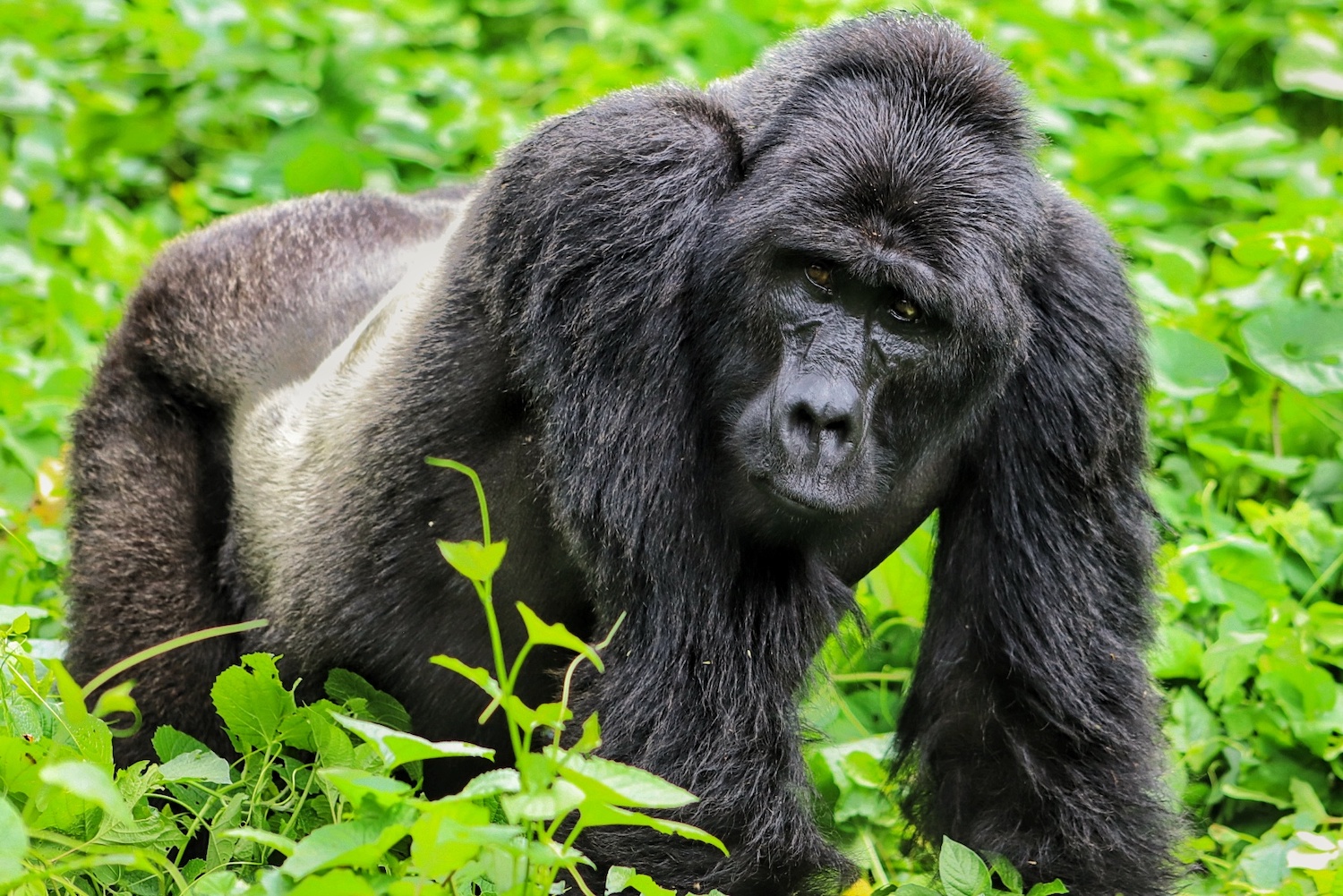
All photos by Jake Emen, except where cited
Thanks for reading InsideHook.
Sign up for our daily newsletter to get more stories just like this.
